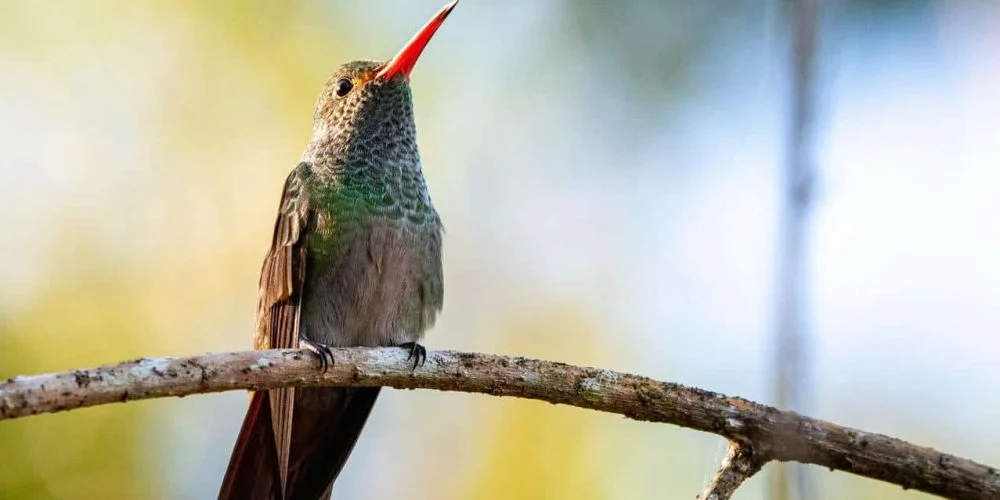
There are 16 different species of hummingbirds present in the state of Arizona.
These are:
- Rivoli’s Hummingbird
- Plain-Capped Starthroat
- Blue-Throated Mountain Gem
- Lucifer Hummingbird
- Ruby-Throated Hummingbird
- Black-Chinned Hummingbird
- Anna’s Hummingbird
- Costa’s Hummingbird
- Broad-Tailed Hummingbird
- Rufous Hummingbird
- Allen’s Hummingbird
- Calliope Hummingbird
- Broad-Billed Hummingbird,
- Berylline Hummingbird
- Violet-crowned Hummingbird
- White-eared Hummingbird
Want to learn more? Take a look at the Compete Hummingbird Guide Book – a classic!
The best place to see hummingbirds in Arizona is in the south east of the state.
Arizona itself has a semiarid desert climate, which means the state has very hot summers and rather mild winters. There are 31 different state parks across Arizona and there are three different national parks.
The most popular of these national parks being the Grand Canyon. After looking at Arizona in small detail, let’s have a closer look at the different species of hummingbirds you can find in the state.
Take a look at our article on the Best Hummingbird Feeder!
What Hummingbirds can be seen in Arizona?
Table of Contents
1. Ruby-throated Hummingbird
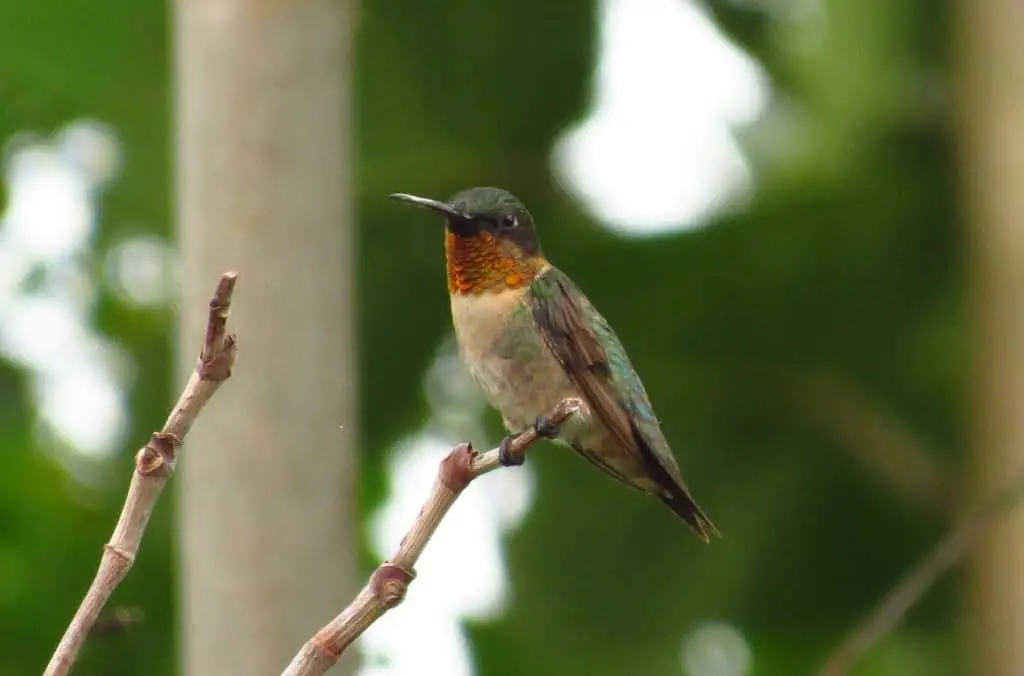
Fun Facts:
- These hummingbirds feed on nectar, particularly the nectar of both orange and red tubular plants such as honeysuckle.
- These birds are tiny and only weigh 2-6g with their wingspan being 8-11cm.
This bird gets its name from its iconic bright red throat. It has a white plumage and the rest of its body is covered in green feathers. These birds like to stay in woodlands but have someone been observed in prairie areas when they are further north.
These birds are quite aggressive but have been seen frequently yielding to larger species such as the Rufous Hummingbird. Males will try to court any females that enter their territory with a flight display.
These birds are not common residents in Arizona and have only been seen in the state during their migratory seasons and in winter.
They have been sighted to the south east of the state. You can easily attract these birds to your garden by using sugar water feeders and tubular plants. In Arizona they are more likely to visit in the colder months.
2. Black-chinned Hummingbird
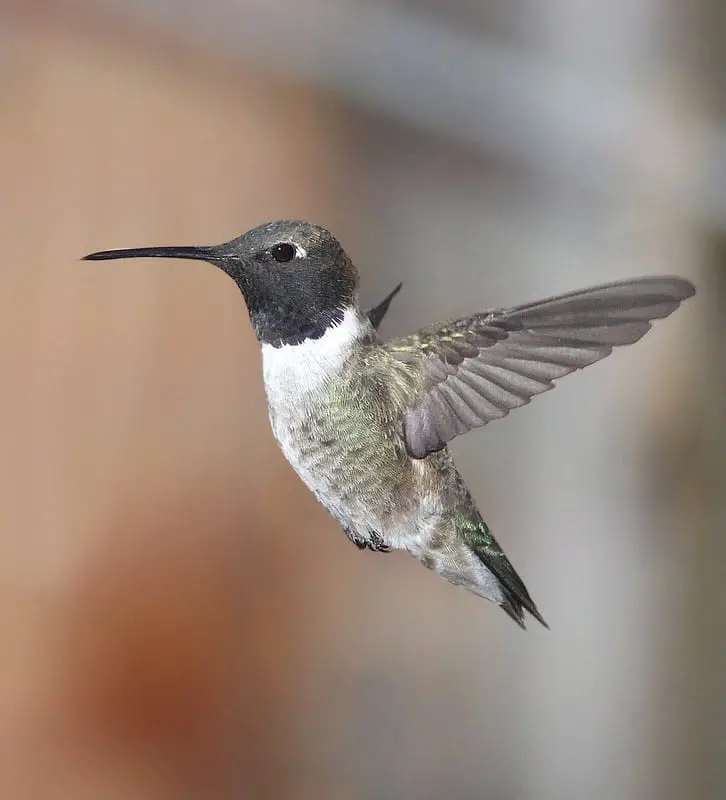
Fun Facts:
- They most commonly consume nectar from flowers but will also eat insects when they are more readily available.
- These birds are very small with a weight range of 2.3-4.9g and have an average wingspan of 11cm.
The black chinned hummingbird has a throat with dark purple and black feathers, which is where it gets its name. its belly is pale and its back and wings are covered in dull pale colours.
These birds are seen most frequently in canyon areas and places close to rivers.
They will perch for a short time after feeding, observing their territory from high above and they will perform a diving display for females during the breeding season. it is assumed that these birds are not monogamous and do not form long term breeding pairs.
These birds can be seen throughout all of Arizona but they are not permanent residents. They can only be seen in the state during their migratory and breeding seasons, most commonly they are seen during their migration.
You are likely to see these birds in the breeding season to the east and in the migratory season to the west.
As long as you keep your sugar water feeder clean and topped up with fresh sugar water daily, it is relatively easy to attract these birds to your garden.
3. Anna’s Hummingbird
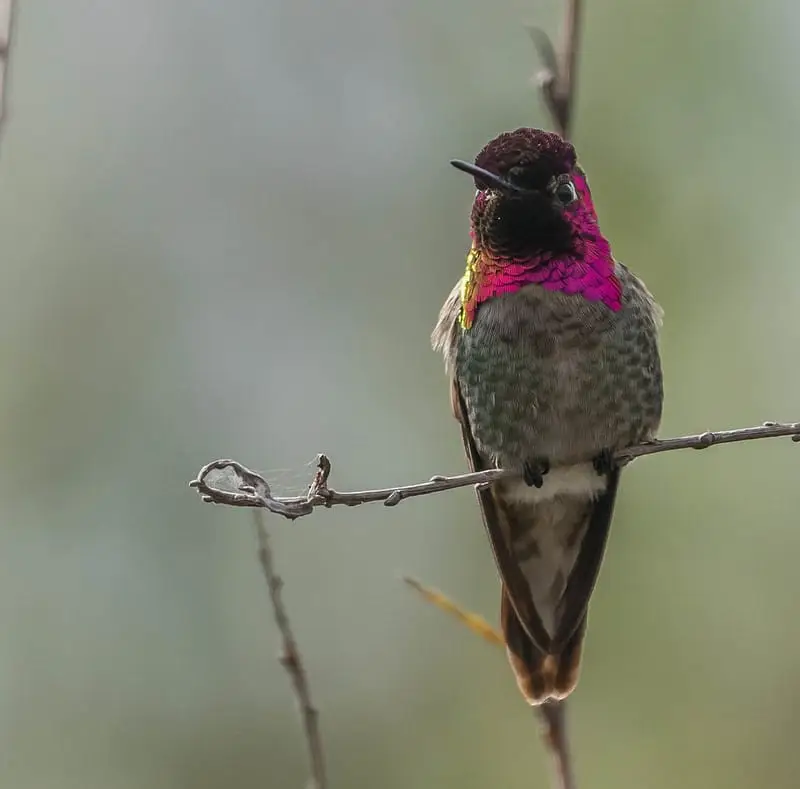
Fun Facts:
- These birds will eat nectar from many different flower species and they have also been known to steal insects from spider webs.
- These birds are medium sized for a hummingbird, weighing 3.6g.
Anna’s Hummingbird has a distinct pink and orange feathered throat and the rest of its body is covered in green feathers.
These birds are very common in suburban and urban areas of land and are frequent visitors to gardens. In this species, males will mate with multiple females and they do not form breeding pairs.
Females are the only ones that contribute to raising the young and each brood consists of 2 eggs. They can have 2 or 3 broods per year and they will bind their nests together using spider webs.
These birds are year-round residents in Arizona and can be seen to the south and the west of the state. In the far south east they have only been recorded outside of their breeding seasons.
Using a hummingbird feeder without adding food colouring or honey is the easiest way to attract one of these birds to your garden. They are frequent garden visitors, especially in the winter.
4. Costa’s Hummingbird
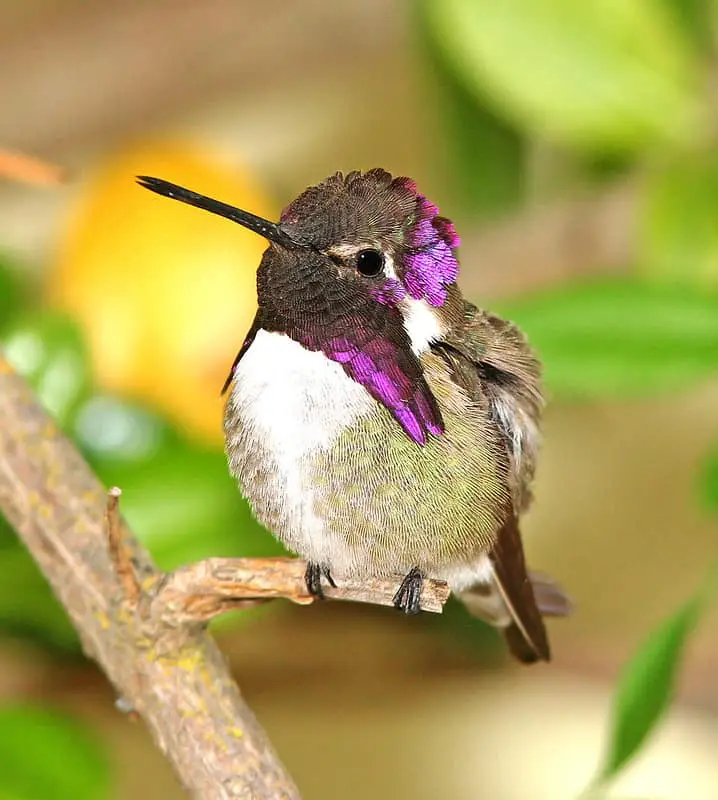
Fun Facts:
- These birds will feed on nectar and will also quite often feed on flying insects.
- Weighing only 2-3g they are slightly smaller on the hummingbird weight scale.
The body of this bird is covered in pale feathers, but its head is made up of bright purple feathers. They will nest in desert areas or in woodlands close to streams.
Males are very defensive of their territories and will pick 3 or 4 different perches from which to observe their territory and look for potential mates.
The longest known courting display of this bird was recorded at 4 minutes whilst the average display only last about 30 to 40 seconds. Males do not help care for the young and will mate with multiple females.
These birds can be seen to the east of the state and have only been observed there during their breeding seasons. Although there have been sightings that appear to span the whole state.
Adding both flowers and sugar water feeders is a great way to try and attract these hummingbirds to your gardens.
5. Broad-tailed Hummingbird
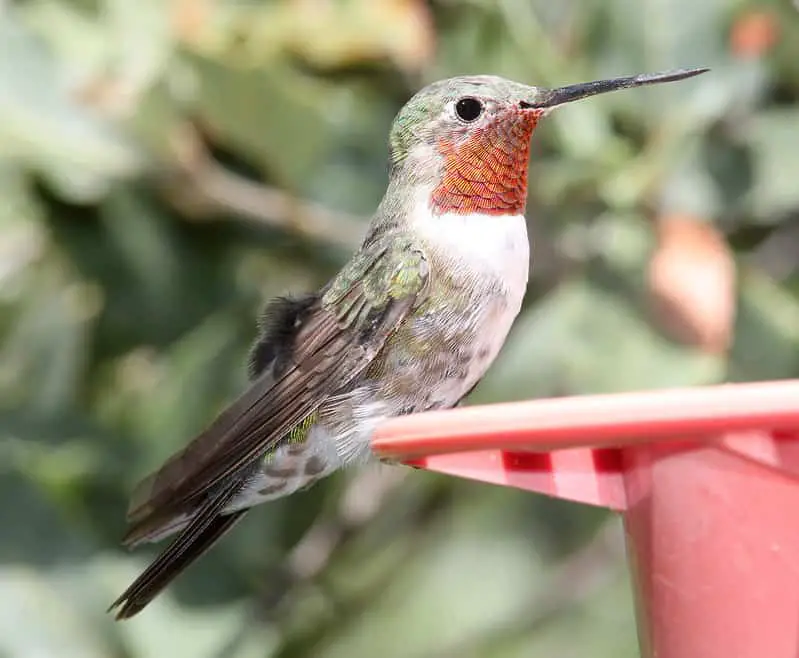
Fun Facts:
- These birds will feed on an even distribution of nectar and insects, mothers will feed insects to their newly hatched young.
- These birds are medium sized for hummingbirds and weigh 2.8-4.5g.
This is a stout hummingbird with broad tail feathers and a pink throat. Its back is covered in green feathers.
These birds prefer to stay in semi-open areas of land such as open woodlands and meadows. Males of this species have one of the most elaborate courtship displays of hummingbirds, but they are not monogamous.
They also do not form breeding pairs and females raise the young on their own. These birds have the ability to go into torpor, which means that they can lower their body heat so that they require less energy.
It is almost like a form of mini hibernation. This also means that a lot of males will fly at night to find the warmest areas in the trees.
These birds are not year-round residents in Arizona, but they can be seen across most of the state. They are only in Arizona during their breeding seasons and the highest number of recorded sightings has been in the central regions of the state.
Adding brightly coloured flowers as well as a sugar water feeder should make it relatively easy to attract one of these birds to your garden.
6. Rufous Hummingbirds
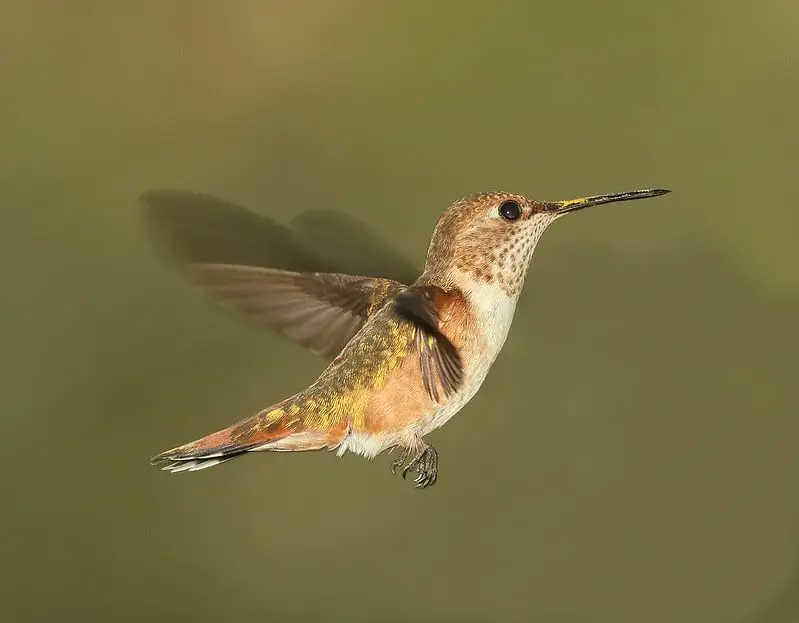
Fun Facts:
- Nectar from tubular plants is the main source of food for this bird.
- These birds are average sized for a hummingbird and weigh 2-5g.
This bird is covered in fall colours of brown and orange and looks very sweet, but it is actually very aggressive to other individuals and other species of hummingbird. They like to stay in areas of open woodlands and are very territorial.
In fact, they are so territorial that males have been seen chasing females away from their food sources, even during the mating season.
These birds are not believed to be monogamous and do not form breeding pairs. The females raise the brood on their own and they are as aggressive as the males.
These birds can be seen across the whole state of Arizona but only during certain times of the year. They are only seen during their migration period.
These birds will come to any garden with sugar water or hummingbird feeders but be warned, they may chase other birds away from your garden.
7. Allen’s Hummingbird
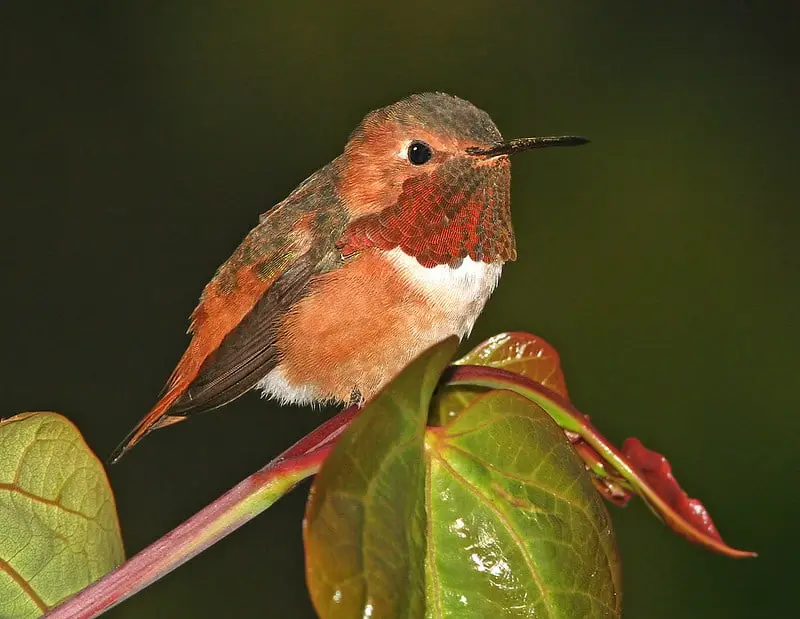
Fun Facts:
- A lot of this bird’s diet comes from nectar, but they will also eat small amounts of insects.
- They are similar in size to a lot of other hummingbirds, weighing 2-4g.
The Allen’s Hummingbird looks very similar to the Rufous Hummingbird, but they have more orange than brown feathers. They like to stay in areas of open woodlands, usually ones along coastlines.
This bird has a flight display that is used to both attract females into their territory to mate and to warn individuals in an aggressive manner.
Females will raise the young on their own whilst the male will mate with several females where possible.
These birds only have a small range and have only been seen in Arizona during their migration period.
The recorded sightings have been reported to be along the west border of the state. These birds are easy to attract to your garden and are often seen feeding at simple sugar water feeders.
8. Calliope Hummingbird
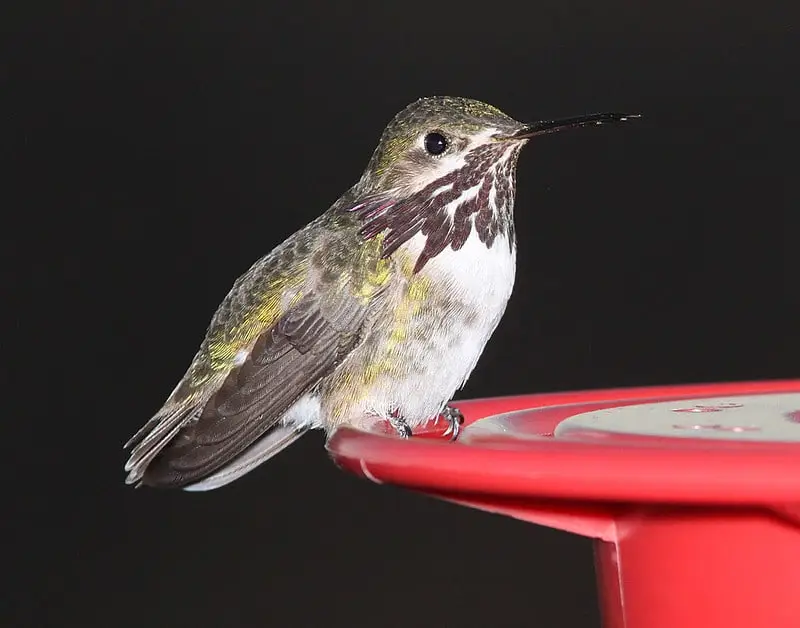
Fun Facts:
- These birds will consume nectar as their main food, usually from cupped flowers.
- Calliope Hummingbirds are on the smaller side only weighing 2.4-3.3g.
This hummingbird has scattered purple feathers across its plumage, a white belly and a dark green back.
These birds tend to stay in mountainous regions such as open mountain woodlands and mountain meadows. Males of this species are territorial and often quite aggressive to other individuals that come too close to their territory.
They do not help the females care for the young, but they have elaborate courtship displays that they will do to multiple different females.
Despite being tiny in size, these birds have been known to chase away other bigger bird species such as American robins.
Their range encompasses almost all of Arizona, but this is only during their migratory period.
The only region of Arizona they cannot be seen in is to the far north east of the state. There are not many tips for attracting this bird to your garden except to put up a sugar water feeder.
9. Broad-billed Hummingbird
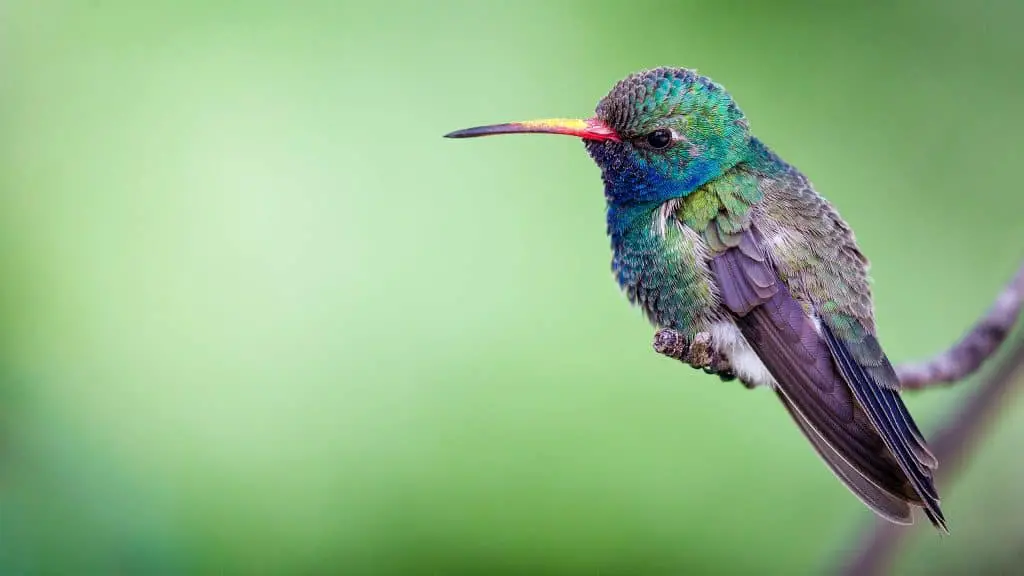
Fun Facts:
- Nectar is the primary food source for these birds but they will also eat insects that they find on plants.
- These birds are average for a hummingbird and have a weight range of 3-4g.
This hummingbird has a short and broad bill that is red in colour with a black tip. The feathers on this bird are made up of blues and greens. These birds like to stay in open areas of woodlands, usually along streams.
Very few individuals remain in the United States during the winter months where they migrate south to Mexico. They will also feed at higher elevations and expand their food search in the colder months.
They are only seen in Arizona during their breeding season and even then, they are not common.
Their range only extends to the south east of the state and rarely go further north. These hummingbirds are most likely to visit your garden if you have colourful species of native flowers planted.
10. Violet-Crowned Hummingbird
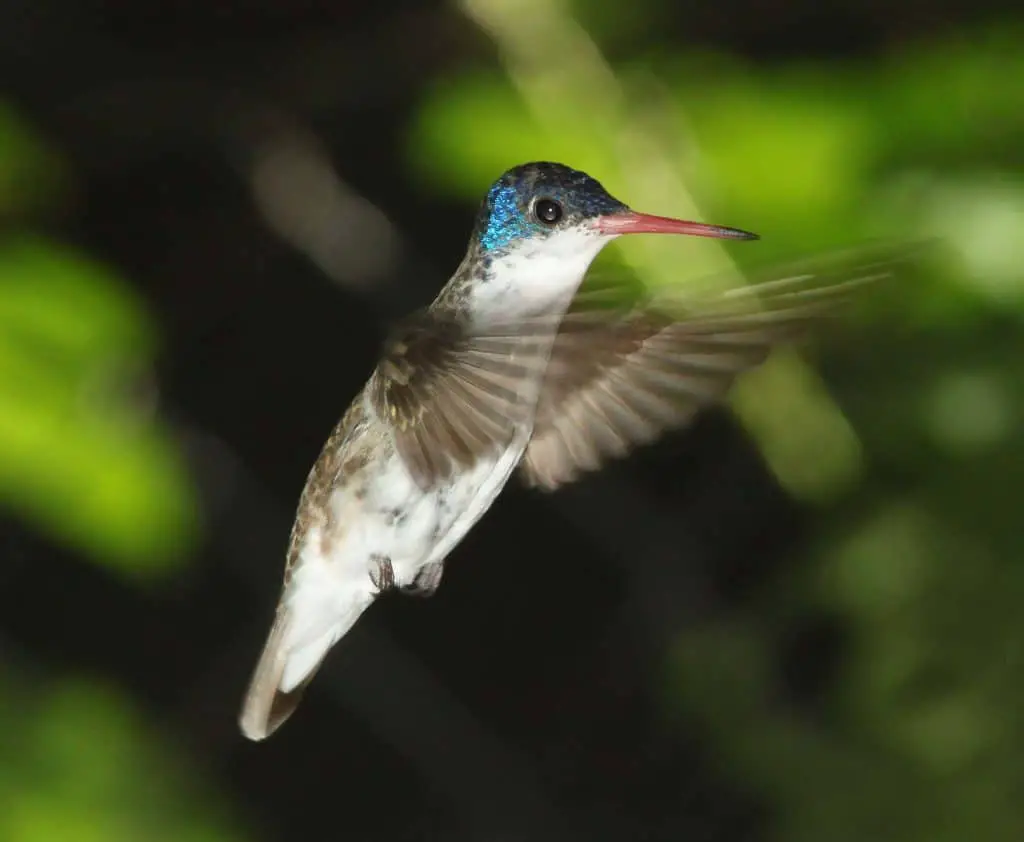
Fun Facts:
- The feed on nectar when flowers are abundant and will consume insects as well.
- They are average sized for a hummingbird, weighing an average of 5g.
The Violet-Crowned Hummingbird is appropriately named for the bright violet feathers on top of this bird’s head.
During the breeding season, these birds can be heard emitting a squeaky song at dawn. However, this is the only known breeding behaviour as the courtship of this bird has not been well studied.
Females are the ones who build the nest and raise the brood. The brood usually consists of about 2 eggs.
These birds are uncommon and have a very small range but can be seen in Arizona during their breeding seasons. They have only been seen to the far south of the state though.
These birds have been observed often using sugar water feeders so be sure to place one of these in your garden if you want one to visit.
11. White-eared Hummingbird
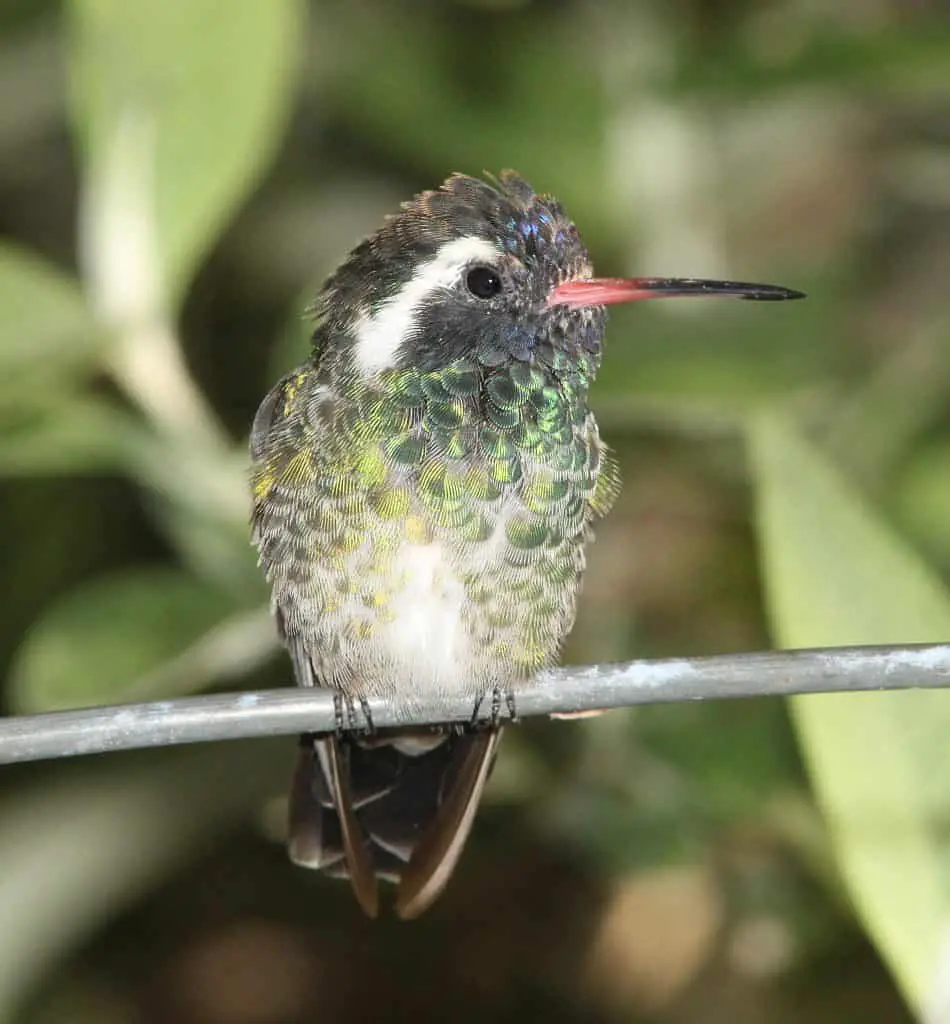
Fun Facts:
- They mostly eat nectar from flowers but will also eat tiny insects.
- They are average sized for a hummingbird and weigh about 4g.
The White-eared Hummingbird does not have ear tufts but instead has white stripes on the side of its face.
The rest of its head it black and its body is green. These birds like to stay mostly in high mountain forest areas, and they are not common in the united states.
Females are the ones to build the nest and raise the young, their broods consisting of only 2 eggs. Males gather in small groups and sing short songs to try and court females.
They have been seen to the east of the state and these sightings have only been during the breeding seasons.
There is not much information on how to attract these birds to your garden but they have been observed using sugar water feeders so make sure to have one of these placed.
12. Rivoli’s Hummingbird
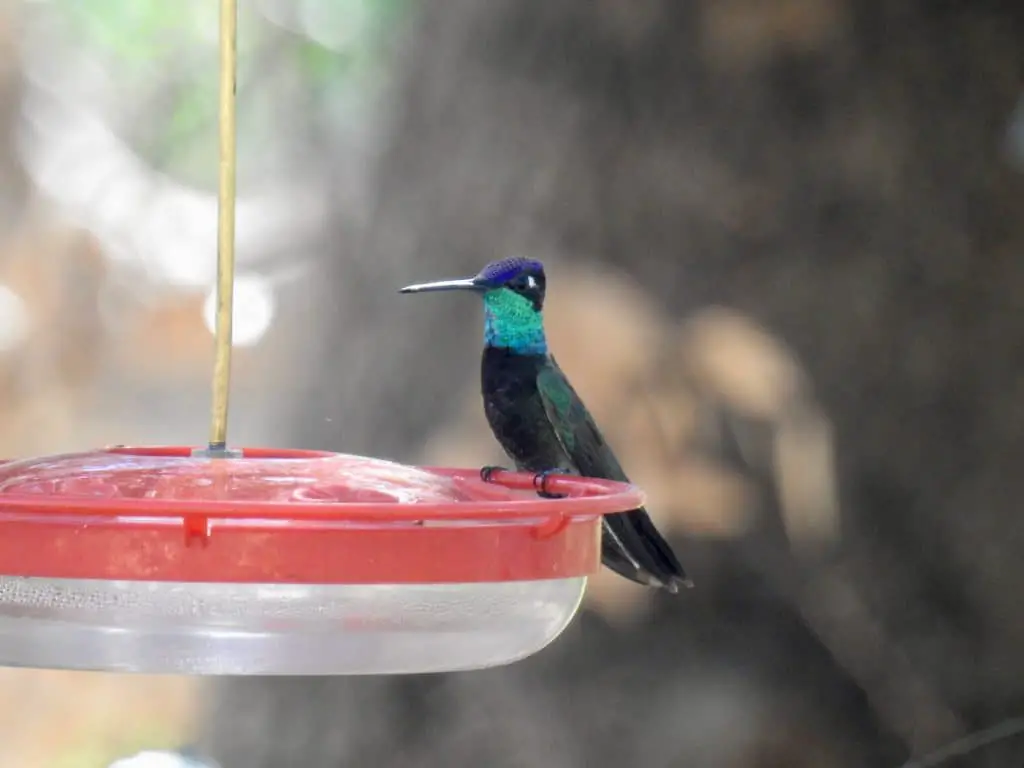
Fun Facts:
- The main diet of a hummingbird consists of nectar as well as lots of insects, particularly during the summer months.
- These birds are on the larger side for hummingbirds and weigh 7-8g.
This species of hummingbird has a striking appearance with its purple crown and emerald feathered throat.
These birds are large in size for hummingbirds and used to be named Magnificent Hummingbirds. Rivoli’s Hummingbirds will nest in pine-oak forests and will also nest in shrubs near garden feeders.
There is no known courtship display of this species and they are believed to be polygamous and do not seem to form long-term breeding pairs.
These birds can be seen in Arizona only during their breeding seasons. Their range does not extend across the whole state and they have only been seen to the south east of Arizona.
Although there have been recorded sightings stretching to the central regions of the state.
These birds are happy to use sugar water feeders and using one may bring them to your garden.
13. Blue-Throated Mountain Gem
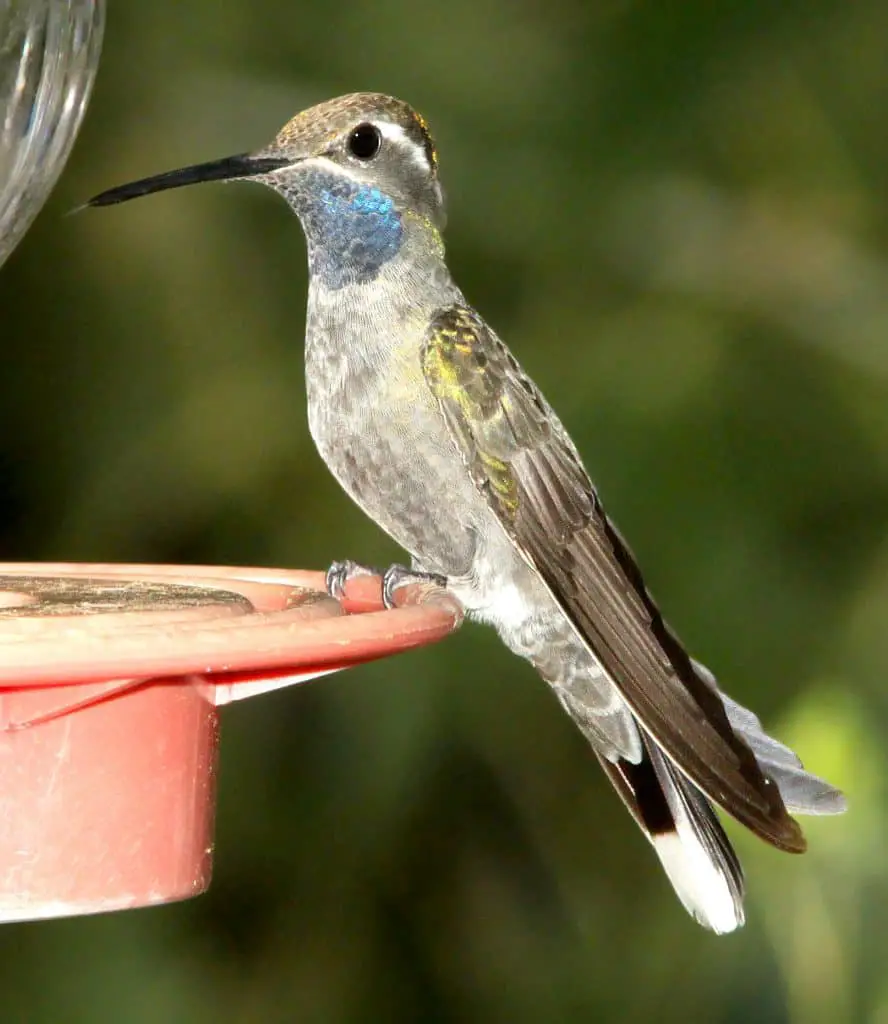
Fun Facts:
- They primarily feed off of nectar and insects but will also eat some spiders.
- These birds are large for a hummingbird and weigh from 8.1-8.6g.
As the name suggests, this bird is identifiable by its rich blue throat. The rest of its body is covered in dull green feathers.
These birds prefer to stay in coniferous woodlands either in or close to the mountains. Whilst these birds have active courting, they do not have flight displays. Instead they use songs to attract females.
Males are, especially during the mating season, territorial and defensive. They have been known to often fight off other males that approach their territory or their mate.
Females are less aggressive but will still push others away from bird feeders.
They are most common in Arizona during their breeding season, but some individuals stay in the far south of the state year-round.
They can be seen along the eastern border of the state and there haven’t been any recorded sightings outside of their range. These birds are happy and frequent visitors to gardens within their range that have sugar water feeders.
14. Lucifer Hummingbird
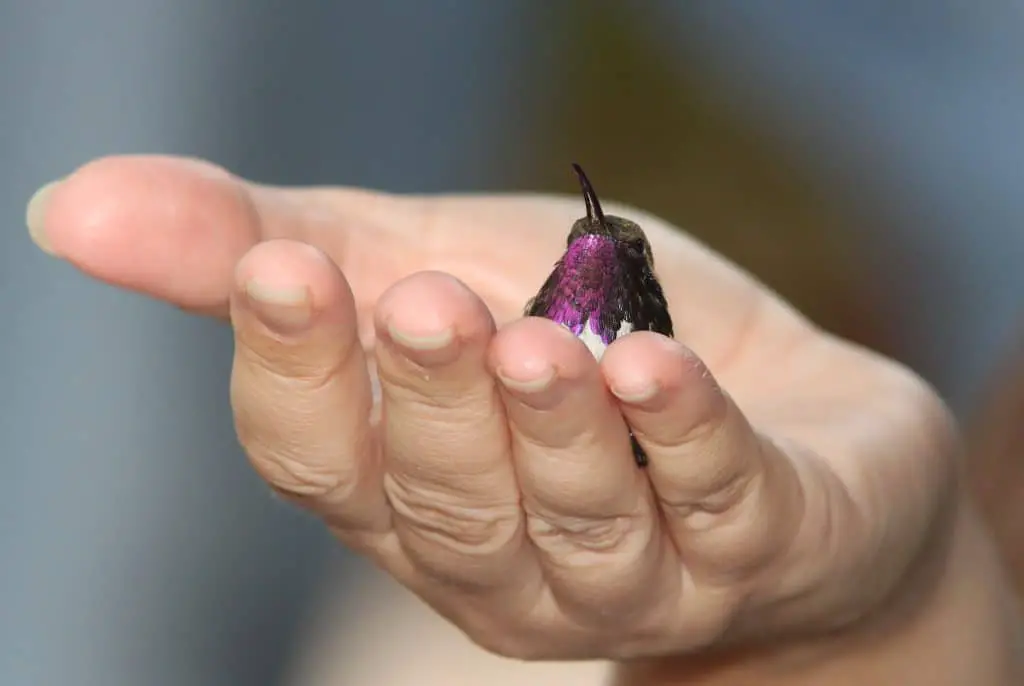
Fun Facts:
- These birds mostly eat nectar, particularly from agave.
- They are medium sized for a hummingbird, weighing around 3-4g.
The Lucifer Hummingbird is mostly covered in dull coloured feathers, but they have bright purple and blue feathered throats.
These birds like to stay in desert foothills and canyon areas. The Lucifer Hummingbird does not appear to mate monogamously or form long term breeding pairs.
The males will court the female will she is building the nest for her brood, they will make sounds with their wings to court her and most of these displays last for about 35 seconds.
These birds are scarce in the state of Arizona and are usually only seen during the breeding seasons. Their recorded sightings have all been to the north east of the state.
These birds do no appear to be frequent garden visitors, but providing them with several food options including sugar water feeders and brightly coloured tubular flowers.
15. Plain-Capped Starthroat
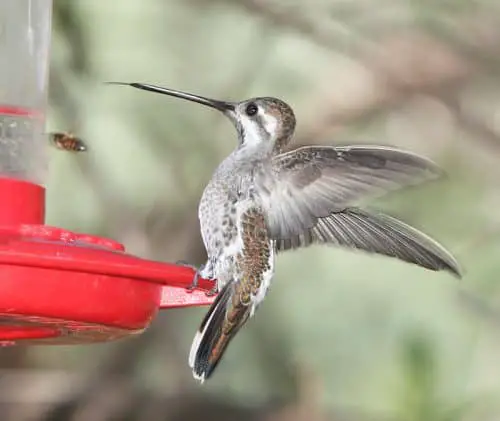
Fun Facts:
- These birds weigh between 7 and 8g.
- Their primary diet consists of nectar.
This species of hummingbird is large in size and prefers mostly open, drier areas of land. These birds have a dark throat and a striped face pattern.
There is not much difference in appearance between the two sexes. Whilst its behaviours have not been well studied, it is known that this bird is a native to Mexico and rarely goes further north than Arizona.
Currently this bird is classified in the conservation category of Least Concern.
The range of this bird extends across the south of Arizona up to the central regions of the state. It has not been sighted in the north.
There is not a lot of information on how to attract these birds to your garden but there have been photographs showing them using sugar water feeders so it is known that they will occasionally visit.
16. Berylline Hummingbird
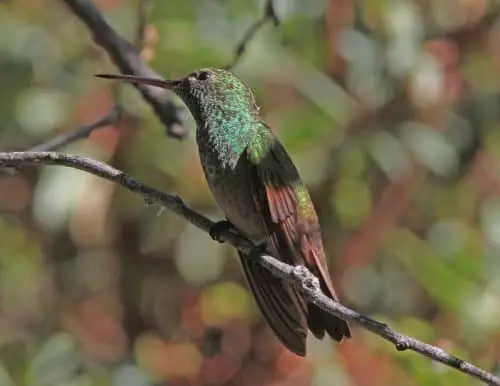
Fun Facts:
- These birds weigh 4-5g.
- They eat nectar and small insects.
The top half of this bird is covered in bright green feathers whilst the bottom half is covered in dark brown feathers.
The breeding behaviour of this bird is not well known but it is presumed that they are not monogamous and do not form breeding pairs.
Females build the nest and use materials such as green lichen to camouflage it against the trees, therefore protecting the eggs from predators.
These birds are most common in Mexico, but they have been observed in Arizona during their breeding seasons. There are not many recorded sightings in Arizona, but they all seem to be to the far south of the state.
They do not appear to be avid garden visitors, but you may be lucky if you have a sugar water feeder and bright tubular plants.

More Articles.
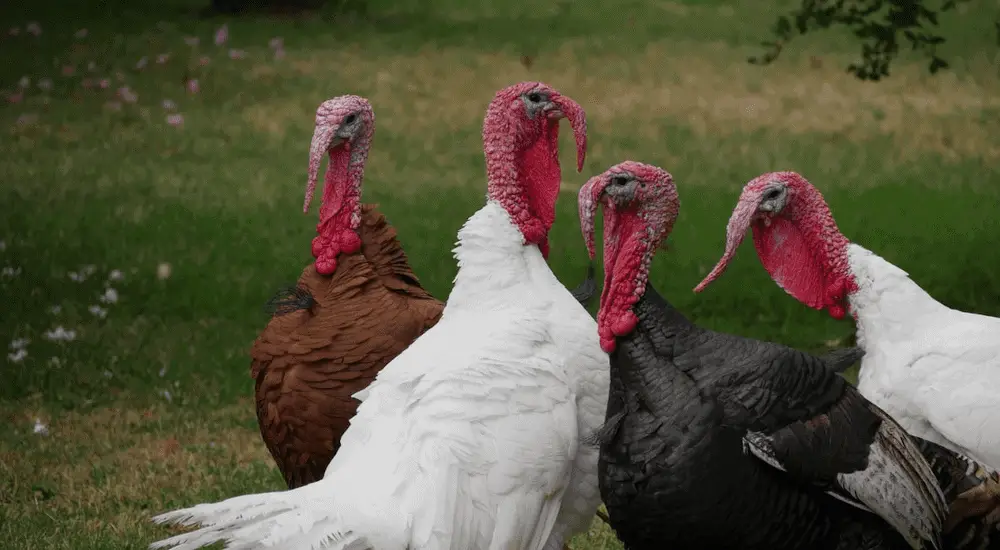
How to attract Wild Turkeys to your yard?
Wild turkeys can be provide quite a fascinating addition to your yard. Providing acorns in
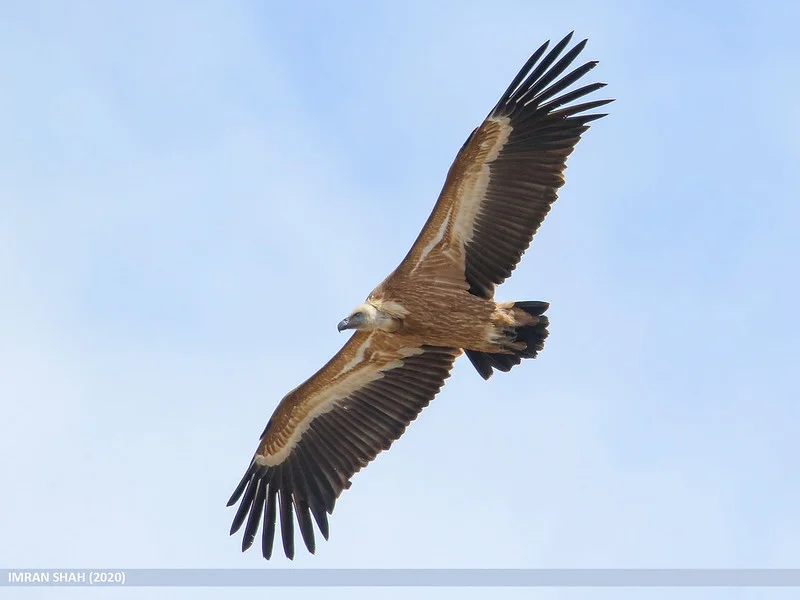
What Birds of Prey can be seen in France? (10 Species with Pictures and Sounds)
France is filled with numerous birds of prey. Its variable habitat from the mountains of
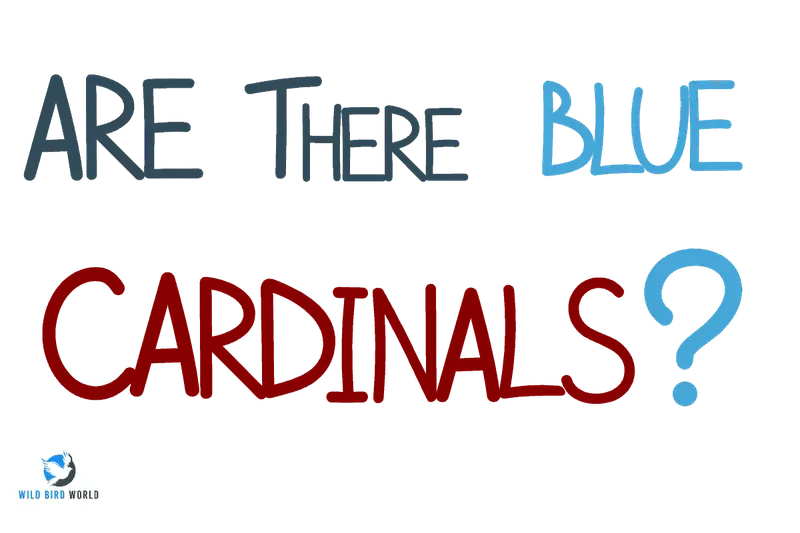
Cardinals are one of the most beautiful birds around and are known to delight birdwatchers

About Us
We are avid bird-watchers who recently retired, allowing us more time to travel the world. Fortunately, we have managed to visit numerous countries around Europe, Asia, and America. Watching and photographing birds has been a passion for many years and we are making the most of the extra time on our hands!
